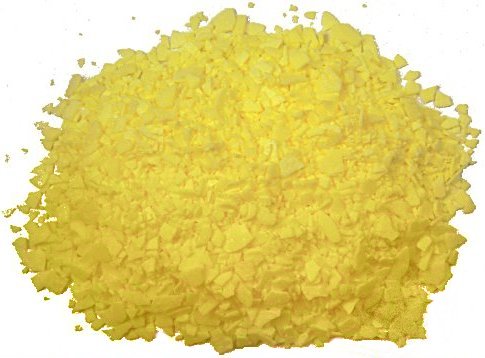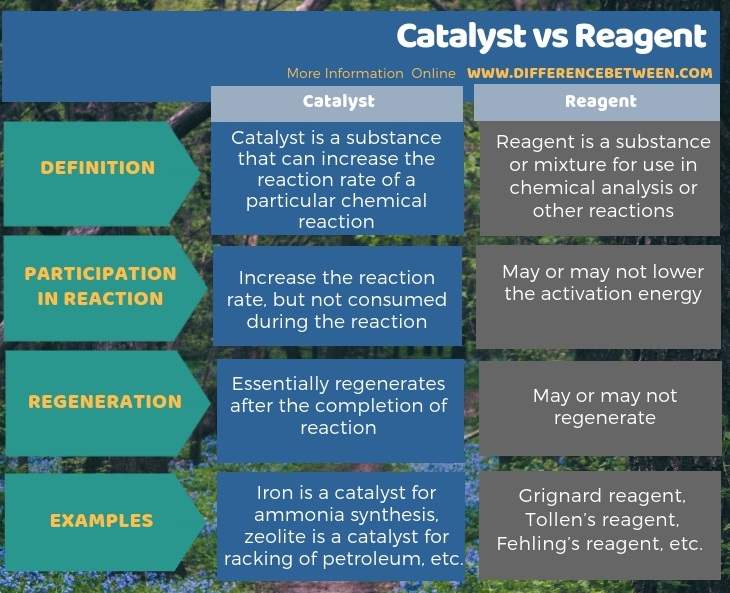Difference Between Catalyst and Reagent
Table of Contents
The key difference between catalyst and reagent is that catalysts are not consumed during the chemical reaction, whereas reagents may or may be consumed during a chemical reaction.
Catalyst and regent are two important terms we often use in analytical chemistry to describe chemical reactions. Some people also use the two terms reagent and reactant interchangeably even though there is a slight difference between them. Catalyst is a substance that can increase the reaction rate of a particular chemical reaction, while reagent is a substance or mixture for use in chemical analysis or other reactions.
CONTENTS
1. Overview and Key Difference
2. What is a Catalyst
3. What is a Reagent
4. Side by Side Comparison – Catalyst vs Reagent in Tabular Form
5. Summary
What is a Catalyst?
Catalyst is a substance that can increase the reaction rate of a particular chemical reaction. The process of increasing the reaction rate is “catalysis”. The most specific property of a catalyst is that the chemical reaction does not consume the catalysts during the progression of the reaction. However, this substance directly participates in the reaction. Therefore, this substance recycles, and we can separate it from the reaction mixture in order to use it in another reaction. Moreover, we need only a small amount of the catalyst for the catalysis of a chemical reaction.
Generally, chemical reactions occur faster when there is a catalyst. It is because this substance can provide an alternative pathway for the reaction to occur. The alternative pathway always has a low activation energy than the usual pathway (which occurs in the absence of catalyst). Moreover, catalyst tends to form an intermediate with the reactant, and it regenerates later. In contrast, if a substance decreases the reaction rate, we call it an inhibitor.

Figure 01: A Graph Showing How a Catalyst Lowers the Activation Energy of a Reaction
We can classify catalysts as either homogeneous or heterogeneous catalysts. If it is homogeneous, it means that the catalyst and reactants are in the same phase of matter (i.e. liquid phase). On the other hand, if the catalyst is in a different phase from that of the reactants, then it is a heterogeneous catalyst. Here, gaseous reactants adsorbed on to a solid catalyst surface.
What is a Reagent?
A reagent is a substance or mixture for use in chemical analysis or other reactions. It can be either a catalyst, which increases the reaction rate or a reactant which is consumed during the reaction.

Figure 02: Sulfur is a Starting Material for Different Synthesis Reactions; thus it is a Reagent
If not, it may not involve in a chemical reaction in any way. For example, solvents such as water can be only the medium for a chemical reaction but not a reactant consumed during a chemical reaction or a catalyst that increases the reaction rate. In addition, reagents are either compounds or mixtures.
What is the Difference Between Catalyst and Reagent?
Catalyst is a substance that can increase the reaction rate of a particular chemical reaction, while reagent is a substance or mixture for use in chemical analysis or other reactions. The key difference between catalyst and reagent is that catalysts are not consumed during the chemical reaction, whereas reagent may or may be consumed during a chemical reaction.
Moreover, a further difference between catalyst and reagent is that the catalysts regenerate after the completion of chemical reaction, while reagents may or may not be regenerated. Some examples for catalysts include iron is a catalyst for ammonia synthesis, zeolite is a catalyst for racking of petroleum, etc. On the other hand, examples for reagents include Grignard reagent, Tollen’s reagent, Fehling’s reagent, etc.

Summary – Catalyst vs Reagent
A catalyst is a substance that can increase the reaction rate of a particular chemical reaction, while a reagent is a substance or mixture for use in chemical analysis or other reactions. The key difference between catalyst and reagent is that catalysts are not consumed during the chemical reaction, whereas reagent may or may be consumed during a chemical reaction.
Reference:
1. Helmenstine, Anne Marie. “Reagent Definition and Examples.” ThoughtCo, May. 8, 2019, Available here.
Image Courtesy:
1. “CatalysisScheme” By Smokefoot assumed. Own work assumed (based on copyright claims) (Public Domain) via Commons Wikimedia
2. “sulfer1” By Mrs Pugliano (CC BY-SA 2.0) via Flickr
ncG1vNJzZmivp6x7pbXFn5yrnZ6YsqOx07CcnqZemLyue8OinZ%2Bdopq7pLGMm5ytr5Wau26vwK2YpbGjqXqiusNmqZ6Zl5q7tXs%3D